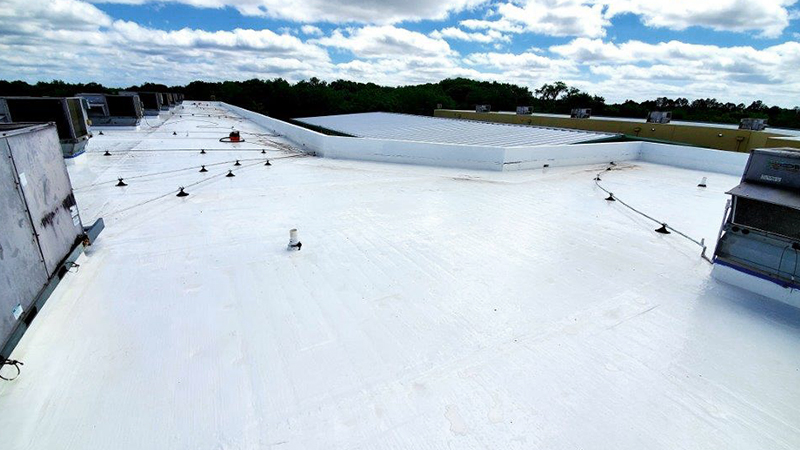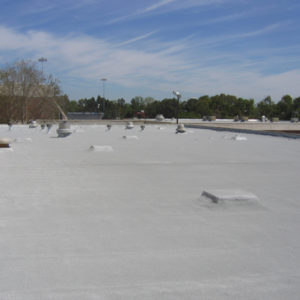As with any type of roofing material, acrylic coating has its pros and cons. It’s a strong, reliable roof coating that can protect your roof from damage — and extend its lifespan. While it does all that, it’s not automatically the right choice for every roof type or situation. There are many situations where acrylic roof coating will thrive and a few where it won’t. Let’s get into the pros and cons of this specific type of roof coating.
Acrylic Roofing Pros
1. Cost. Acrylic coatings are much more cost-effective than a new roofing system. When they’re applied correctly, they can last just as long, too.
2. Solar reflectance. The coating is UV-resistant and its light-reflecting properties result in lower energy costs. How much protection you get from the coating varies by product, but Aldo’s acrylic coatings provide 82% – 86% solar reflectance of UV rays, something that doesn’t fade over time.

3. Easy application. Acrylic roof coatings apply easily and smoothly, even on rough, textured surfaces. They can be applied just like paint — with a brush, roller or sprayer. No specialty equipment is required. The adhesion won’t fade over time, either. It looks like normal house paint, but it goes on 5 to 10 times thicker for ultimate protection against the elements.
4. Resists damage. Aldo’s acrylic coatings resist mechanical damage, chemical attacks and dirt buildup, and have great UV protection. Plus, many are fire-retardant.
5. Ideal for sloped roofs. Acrylic coatings work well on BUR and single-ply restoration. They are not ideal for use on roofs with less than a 1:24 ratio roof pitch, or slope. If they are used and consistently exposed to ponding water, the risk of poor adhesion and blistering comes into play.
6. Environmentally friendly. Water-based acrylic formulas have much lower levels of volatile organic compound (VOC) than other types of coatings.
Acrylic Roofing Cons
1. Breaks down under ponding water. Acrylic coatings are water-resistant but aren’t immune to issues that result from ponding water. Ponding water causes commercial roofs to break down over time because the acrylic formula is water-based, while other types, such as silicone roof coatings, are not. If you have a flat roof surface that’s prone to ponding, consider choosing one of our other types of commercial roof coating.
2. Temperature matters for application. The coatings can withstand cold temperatures once they’re applied and cured, but they must fully cure first. If the temperature is below 50 degrees, acrylic coatings won’t be able to cure properly. That’s due to the water-based formula, as the water within the coating can freeze and cause adhesion issues. Keep this in mind and apply it at the right time of year for your region. Excessive humidity or heat can also hinder acrylic coatings’ curing ability.
3. Lose thickness as they age. Acrylic coatings can break down quicker, resulting in a shorter lifespan than other types of coatings if they’re consistently exposed to extreme weather conditions.
The acrylic roofing pros and cons have been covered. Now, you and other building owners can decide whether acrylic is the best coating choice for your type of roof. If you want to save money and still get protection and longevity out of your roofing, acrylic products are a great choice. They give you a unique and powerful combination of cost and performance you can’t find in other types of coating.



